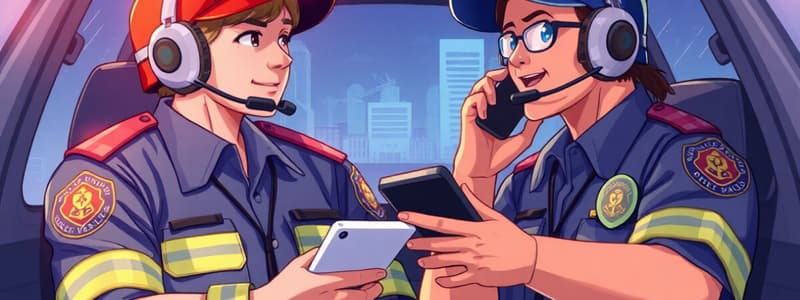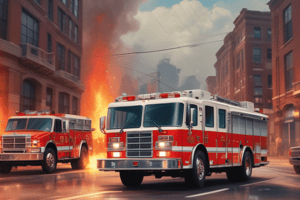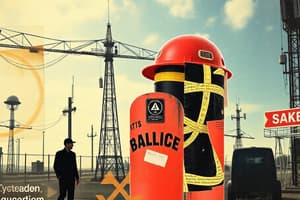Podcast
Questions and Answers
Public safety communications is a customer service-oriented profession.
Public safety communications is a customer service-oriented profession.
True (A)
Customer service is ______ in public safety communications.
Customer service is ______ in public safety communications.
important
Why is customer service important in public safety communications?
Why is customer service important in public safety communications?
Ensuring callers receive timely and accurate assistance in emergency situations contributes to public safety. Effective communication can help to de-escalate situations and provide reassurance to callers.
Which of the following best describes the nature of public safety communications?
Which of the following best describes the nature of public safety communications?
Match the following terms to their respective descriptions:
Match the following terms to their respective descriptions:
Public safety communications is not considered a customer service-oriented profession.
Public safety communications is not considered a customer service-oriented profession.
What is one primary benefit of having good customer service in public safety communications?
What is one primary benefit of having good customer service in public safety communications?
The text states that the answer to whether public safety communications is a customer service-oriented profession is ______.
The text states that the answer to whether public safety communications is a customer service-oriented profession is ______.
The public's perception of a professional telecommunicator is not important.
The public's perception of a professional telecommunicator is not important.
According to Webster's, what is a key element of professionalism?
According to Webster's, what is a key element of professionalism?
Telecommunicators have _____________ authority, which means they make decisions about sending responders.
Telecommunicators have _____________ authority, which means they make decisions about sending responders.
Why is it important for telecommunicators to use courtesy in their communications?
Why is it important for telecommunicators to use courtesy in their communications?
What is a common reason telecommunicators might become jaded to calls?
What is a common reason telecommunicators might become jaded to calls?
Match the following statements with the correct concept:
Match the following statements with the correct concept:
What is the significance of the quote 'Always give people more than they expect to get' in the context of customer service?
What is the significance of the quote 'Always give people more than they expect to get' in the context of customer service?
Telecommunicators should prioritize their own emotional well-being over the needs of callers.
Telecommunicators should prioritize their own emotional well-being over the needs of callers.
What is one responsibility of telecommunicators when answering 9-1-1 calls?
What is one responsibility of telecommunicators when answering 9-1-1 calls?
Procedures are designed to be vague to allow for flexibility in handling emergencies.
Procedures are designed to be vague to allow for flexibility in handling emergencies.
What do public safety telecommunicators help establish through their policies and procedures?
What do public safety telecommunicators help establish through their policies and procedures?
The telecommunicator must answer all ___ lines by the third ring.
The telecommunicator must answer all ___ lines by the third ring.
Why was there no specific procedure for handling the events of September 11, 2001?
Why was there no specific procedure for handling the events of September 11, 2001?
Match the following responsibilities with their descriptions:
Match the following responsibilities with their descriptions:
Telecommunicators have limited roles and responsibilities.
Telecommunicators have limited roles and responsibilities.
What must telecommunicators do with their PSAP's policies and procedures?
What must telecommunicators do with their PSAP's policies and procedures?
What is the main purpose of open-ended questions?
What is the main purpose of open-ended questions?
Paraphrasing is only useful when the sender has communicated clearly.
Paraphrasing is only useful when the sender has communicated clearly.
What are the '4 W’s' in basic telecommunicator training?
What are the '4 W’s' in basic telecommunicator training?
Reflecting feelings involves repeating the sender's emotions in a short, ______ statement.
Reflecting feelings involves repeating the sender's emotions in a short, ______ statement.
Match the communication technique with its description:
Match the communication technique with its description:
Which of the following is NOT a benefit of using open-ended questions?
Which of the following is NOT a benefit of using open-ended questions?
What is the primary purpose of a Computer-Aided Dispatch (CAD) system?
What is the primary purpose of a Computer-Aided Dispatch (CAD) system?
Paraphrasing indicates that the listener has not understood the sender.
Paraphrasing indicates that the listener has not understood the sender.
24-Hour Time is often used in radio communications to clarify timing.
24-Hour Time is often used in radio communications to clarify timing.
Provide an example of an open-ended question.
Provide an example of an open-ended question.
What technology utilizes satellite systems to track vehicles?
What technology utilizes satellite systems to track vehicles?
The ______ is responsible for regulating radio communications in the United States.
The ______ is responsible for regulating radio communications in the United States.
Match the following radio communication procedures with their descriptions:
Match the following radio communication procedures with their descriptions:
Which of the following is NOT a function of a Record Management System?
Which of the following is NOT a function of a Record Management System?
Radio Frequency refers to the range of electromagnetic frequencies used for transmitting data wirelessly.
Radio Frequency refers to the range of electromagnetic frequencies used for transmitting data wirelessly.
What is one major benefit of CAD interoperability?
What is one major benefit of CAD interoperability?
Mapping systems are used in CAD to provide ______ features for better situational awareness.
Mapping systems are used in CAD to provide ______ features for better situational awareness.
Which radio equipment is essential for field communication between units?
Which radio equipment is essential for field communication between units?
What is the primary role of a Public Safety Answering Point (PSAP)?
What is the primary role of a Public Safety Answering Point (PSAP)?
A primary PSAP is the second communications center to answer a 9-1-1 call.
A primary PSAP is the second communications center to answer a 9-1-1 call.
What does PSAP stand for?
What does PSAP stand for?
The role of a public safety telecommunicator requires specialized knowledge, attributes, and skills not commonly found in other __________.
The role of a public safety telecommunicator requires specialized knowledge, attributes, and skills not commonly found in other __________.
Which of the following best describes the importance of ethics in public safety communications?
Which of the following best describes the importance of ethics in public safety communications?
Match the following concepts with their correct descriptions:
Match the following concepts with their correct descriptions:
Public safety telecommunicators need to know about physical and political jurisdictional boundaries.
Public safety telecommunicators need to know about physical and political jurisdictional boundaries.
List two vital services of public safety communications.
List two vital services of public safety communications.
Flashcards
What is a CAD system?
What is a CAD system?
A system that helps dispatchers manage calls, track units, and provide information to responders.
Mobile Data Systems
Mobile Data Systems
Mobile data terminals (MDTs) are used by responders in their vehicles to access information from the CAD system and provide updates.
24-Hour Time
24-Hour Time
A 24-hour time format uses a 00:00 to 23:59 scale, eliminating the need for AM or PM designations.
Mapping Systems
Mapping Systems
Signup and view all the flashcards
Automated Vehicle Locator (AVL)
Automated Vehicle Locator (AVL)
Signup and view all the flashcards
Record Management Systems
Record Management Systems
Signup and view all the flashcards
CAD Interoperability
CAD Interoperability
Signup and view all the flashcards
Initiating Radio Traffic
Initiating Radio Traffic
Signup and view all the flashcards
Broadcast Procedures
Broadcast Procedures
Signup and view all the flashcards
Acknowledging Radio Transmissions
Acknowledging Radio Transmissions
Signup and view all the flashcards
What is a PSAP?
What is a PSAP?
Signup and view all the flashcards
Who is a Public Safety Telecommunicator?
Who is a Public Safety Telecommunicator?
Signup and view all the flashcards
What are ethics and values in public safety communications?
What are ethics and values in public safety communications?
Signup and view all the flashcards
What is organizational structure in a PSAP?
What is organizational structure in a PSAP?
Signup and view all the flashcards
What's the role of basic telecommunications elements in public safety communications?
What's the role of basic telecommunications elements in public safety communications?
Signup and view all the flashcards
What are the vital services of public safety communications?
What are the vital services of public safety communications?
Signup and view all the flashcards
What are informational resources in a PSAP?
What are informational resources in a PSAP?
Signup and view all the flashcards
Why is knowing physical and political boundaries important for a PSAP?
Why is knowing physical and political boundaries important for a PSAP?
Signup and view all the flashcards
Procedure
Procedure
Signup and view all the flashcards
Policy
Policy
Signup and view all the flashcards
September 11th Example
September 11th Example
Signup and view all the flashcards
Telecommunicator Responsibility
Telecommunicator Responsibility
Signup and view all the flashcards
Knowledge and Understanding
Knowledge and Understanding
Signup and view all the flashcards
Standard of Care
Standard of Care
Signup and view all the flashcards
Telecommunicator's Role
Telecommunicator's Role
Signup and view all the flashcards
Telecommunicator Responsibilities
Telecommunicator Responsibilities
Signup and view all the flashcards
Open-Ended Questions
Open-Ended Questions
Signup and view all the flashcards
Paraphrasing
Paraphrasing
Signup and view all the flashcards
Reflecting Feelings
Reflecting Feelings
Signup and view all the flashcards
The 4 W's
The 4 W's
Signup and view all the flashcards
Simplified Explanations
Simplified Explanations
Signup and view all the flashcards
Effective Communication
Effective Communication
Signup and view all the flashcards
Active Listening Techniques
Active Listening Techniques
Signup and view all the flashcards
Basic Telecommunicator Training
Basic Telecommunicator Training
Signup and view all the flashcards
Customer service
Customer service
Signup and view all the flashcards
Public safety communication as customer service
Public safety communication as customer service
Signup and view all the flashcards
Telecommunicators' role in customer service
Telecommunicators' role in customer service
Signup and view all the flashcards
Customer service in emergency calls
Customer service in emergency calls
Signup and view all the flashcards
Communicating instructions effectively
Communicating instructions effectively
Signup and view all the flashcards
Professional communication in emergencies
Professional communication in emergencies
Signup and view all the flashcards
Calming callers during emergencies
Calming callers during emergencies
Signup and view all the flashcards
Handling information efficiently
Handling information efficiently
Signup and view all the flashcards
What is professionalism in public safety communications?
What is professionalism in public safety communications?
Signup and view all the flashcards
What is emotional resilience for a telecommunicator?
What is emotional resilience for a telecommunicator?
Signup and view all the flashcards
What is the importance of courtesy in public safety communications?
What is the importance of courtesy in public safety communications?
Signup and view all the flashcards
What is operational authority in public safety communications?
What is operational authority in public safety communications?
Signup and view all the flashcards
What is the role of the caller in public safety?
What is the role of the caller in public safety?
Signup and view all the flashcards
What is compassion fatigue in public safety communications?
What is compassion fatigue in public safety communications?
Signup and view all the flashcards
Why is it important to focus on the caller in public safety communications?
Why is it important to focus on the caller in public safety communications?
Signup and view all the flashcards
What is the key to excellent customer service in public safety communications?
What is the key to excellent customer service in public safety communications?
Signup and view all the flashcards
Study Notes
Public Safety Telecommunicator 1 - Seventh Edition Study Notes
- Copyright and Publication Information: Copyright 2016 by APCO Institute. Published by APCO Institute. ISBN 978-1-57927-055-1. Printed in the United States. Contact information for APCO Institute provided.
Author and Editor
- Author: APCO Institute, APCO International, Daytona Beach, FL
- Editor: Timothy Scanlon, Curriculum Developer, APCO Institute, Daytona Beach, FL
- Contributors: A list of individuals contributing to the text. Includes their professional affiliations and roles.
Dedication
- Dedication: To Diane L. Beatty, a Professional Development Specialist for Allegheny County Emergency Services. A friend, mentor, and instructor who touched the lives of 1800 students.
Table of Contents
- Module 1: Introduction To Your New Career: Covers the role of a Professional Public Safety Telecommunicator, ethics and values, PSAP organizational structure, basic communication elements, services from the system, PSAP resources, geographic service areas, policies and procedures.
- Module 2: Interpersonal Communications: Covers nonverbal communication, the role of the communication cycle, techniques for effective hearing and listening, speech and diction, observations and inferences, customer service and quality assurance in emergency communications.
- Module 3: Telephone Communications Techniques: Call Processing: This module is about call processing, basic call processing techniques, information gathering, describing callers and different caller types, use of guidecards.
- Module 4: Telephony, Traditional Technology: covers the telephone, telephone technologies, call routing (PBX systems and call boxes).
- Module 5: Next Generation 9-1-1: Discusses changes in communication technology related to 9-1-1, the architecture of NG9-1-1, Text-to-9-1-1, other technologies for public safety, and challenges to public safety in the Digital Age.
- Module 6: Telephony: TTY: Covers TTY technology, recognizing TTY calls, understanding TTY communications, techniques for handling TTY calls for service, relay services (TRS) and video relay service (VRS).
- Module 7: Telematics & Collision Notification Systems: Describes the system components and functionality, general guidelines for telematics calls (voice and no voice) , specific call types and other driver assistant systems.
- Module 8: Computer-Aided Dispatch (CAD) and Related Technologies This covers various aspects of CAD, mobile data systems, mapping systems, automated vehicle locators (AVLs), logging recorders, record management, and CAD interoperability.
- Module 9: Radio Communications Techniques: In this module there are sections on initiating radio traffic, broadcast procedures, acknowledging radio transmissions, response unit safety, procedures for law enforcement and fire service and EMS and the role of the FCC
- Module 10: Radio Technology: This module covers what radio is, the history of public safety radio systems, radio equipment, care and maintenance of radio equipment, radio systems, radio Frequency and radio interoperability.
- Module 11: Call Classifications: This module describes different call types, including in progress, just occurred, and delayed. Separate sections on various call types including Law Enforcement, Fire, EMS, and Responder Initiated calls are also included.
- Module 12: NIMS Incident Command System: Defines the National Incident Management System (NIMS), ICS concepts and principles, and explains the role of command and general staff in various roles.
- Module 13: Liability Issues: Explores the overview of civil liability law, exposure, call processing considerations, confidentiality, and minimizing liability risks.
- Module 14: Preparing for Your New Career: This module delves into shift work and stress, mental/physical stress management, secondary stress, tips for reducing stress, teamwork, on-the-job issues, CISD and professional development.
- Glossary: Provides definitions for key terms used throughout the course.
Open Book Exercises
- Module One Summarizes the attributes of a professional telecommunicator, defines “Duty to Serve”, explains confidentiality, organizational structure, basic telecommunications elements, and services.
- Module Two Lists the combined verbal and nonverbal elements that communicate situations, the parts of the communications cycle, defines many interpersonal communication elements, such as active listening, open-ended questions, paraphrasing, and reflecting feelings, and details the common impediments to active listening.
- Module Three Explains call processing, details of appropriate greetings for 9-1-1 and non-emergency calls, call-processing techniques, descriptive information gathering, managing caller types, etc., and defines several useful terms
- Module Four Covers various aspects of telephony technologies (and their functions) that are traditional to communications.
- Module Five Describes changes in consumer communications technology relevant to 9-1-1 service, the basic architecture of NG9-1-1 service, the role of FirstNet in modern public safety communications, text-to-9-1-1 and the implementation timelines
- Module Six Covers TTY technology, and communications issues relevant to those with hearing impairments
- Module Seven Covers telematics and collision notification system components, general guidelines for the handling of telematics calls, and different types of telematics calls
- Module Eight Covers computer-aided dispatch (CAD) systems and many technological components
- Module Nine Covers radio communications techniques, both theoretical and practical
- Module Ten Discusses radio technology, including history, equipment, maintenance, communications, frequency and interoperability.
- Module Eleven Outlines call classifications, including incidents in progress, just occurred, delayed, or those involving a missing person, as example
- Module Twelve Covers the structure and functions of the National Incident Management System (NIMS) and Incident Command System (ICS).
- Module Thirteen Outlines various legal aspects of liability exposure for the telecommunicator including the standard of care, confidentiality, minimizing liability risks.
- Module Fourteen Explores a wide variety of issues related to preparing for a new career in public safety communications, including teamwork, shift work, and stress management.
Studying That Suits You
Use AI to generate personalized quizzes and flashcards to suit your learning preferences.





